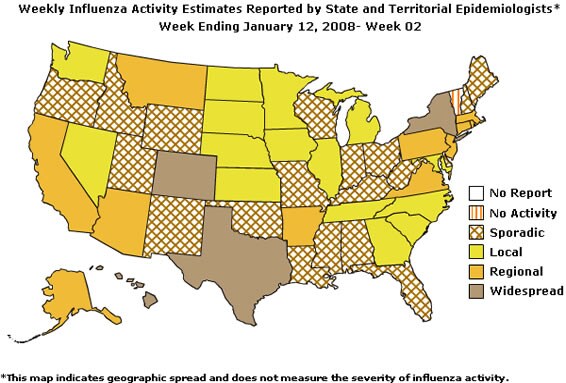Error processing SSI file
Weekly Report: Influenza Summary Update
2007-2008 Influenza Season Week 2, ending January 12, 2008
(All data are preliminary and may change as more reports are received.)Synopsis
During week 2 (January 6 - 12, 2008), influenza activity continued to increase in the United States.
- Two hundred eighty-three (9.8%) specimens tested by U.S. World Health Organization (WHO) and National Respiratory and Enteric Virus Surveillance System (NREVSS) collaborating laboratories were positive for influenza.
- The proportion of deaths attributed to pneumonia and influenza was equal to the epidemic threshold.
- The proportion of outpatient visits for influenza-like illness (ILI) was above national baseline levels, and the proportion of outpatient visits for acute respiratory illness (ARI) was below national baseline levels. The East North Central, Mountain, Pacific, West North Central, and West South Central regions reported ILI above their region-specific baselines.
- Four states reported widespread influenza activity; 11 states reported regional influenza activity; the District of Columbia and15 states reported local influenza activity; 19 states reported sporadic influenza activity; and one state reported no influenza activity.
Region |
Data for current week | Data cumulative for the season | |||||||
|---|---|---|---|---|---|---|---|---|---|
| Sentinel Provider ILI* | DoD and VA ARI* | % pos. for flu† | # jurisdictions reporting regional or widespread activity‡ | A (H1) | A (H3) | A Unsub-typed | B | Pediatric Deaths | |
| Nation | Elevated | Normal | 9.8 % | 15 of 51 | 397 | 118 | 1386 | 285 | 1 |
| New England | Normal | Normal | 3.6 % | 3 of 6 | 18 | 1 | 42 | 25 | 0 |
| Mid-Atlantic | Normal | Normal | 4.6 % | 3 of 3 | 8 | 2 | 54 | 49 | 0 |
| East North Central | Elevated | Normal | 17.7 % | 0 of 5 | 43 | 22 | 7 | 31 | 0 |
| West North Central | Elevated | Normal | 4.0 % | 0 of 7 | 10 | 4 | 56 | 17 | 0 |
| South Atlantic | Normal | Normal | 7.2 % | 1 of 9 | 23 | 21 | 243 | 50 | 0 |
| East South Central | Normal | Normal | 3.3 % | 0 of 4 | 3 | 4 | 5 | 1 | 0 |
| West South Central | Elevated | Normal | 7.3 % | 2 of 4 | 17 | 44 | 678 | 35 | 1 |
| Mountain | Elevated | Normal | 15.2 % | 3 of 8 | 159 | 11 | 180 | 55 | 0 |
| Pacific | Elevated | Normal | 7.0 % | 3 of 5 | 116 | 9 | 121 | 22 | 0 |
* Elevated means the % of visits for ILI or ARI is at or above the national or
region-specific baseline
?National data is for current week; regional data is for the most recent 3 weeks.
?Includes all 50 states and the District of Columbia
Laboratory Surveillance
During week 2, WHO and NREVSS laboratories reported 2,880 specimens tested for influenza viruses, 283 (9.8%) of which were positive, including 60 influenza A (H1) viruses, 17 influenza A (H3) viruses, 166 influenza A viruses that were not subtyped, and 40 influenza B viruses. The District of Columbia and 42 states from all nine surveillance regions have reported laboratory-confirmed influenza this season.
Since September 30, 2007, WHO and NREVSS laboratories have tested a total of 56,442 specimens for influenza viruses and 2,186 (3.9%) were positive. Among the 2,186 influenza viruses, 1,901 (87.0%) were influenza A viruses and 285 (13.0%) were influenza B viruses. Five hundred fifteen (27.1%) of the 1,901 influenza A viruses have been subtyped: 397 (77.1%) were influenza A (H1) viruses and 118 (22.9%) were influenza A (H3) viruses.
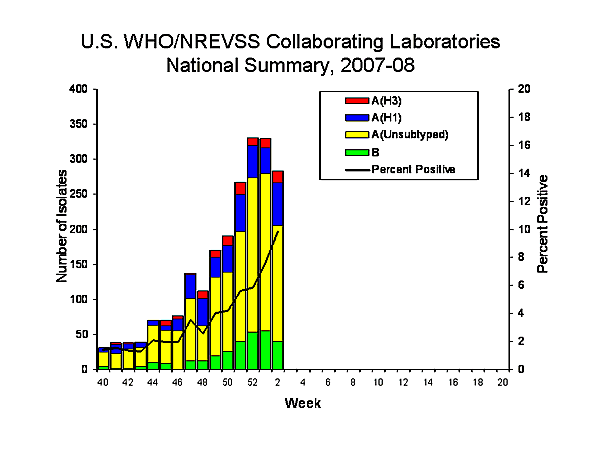
View WHO-NREVSS Regional Bar Charts | View Chart Data | View Full Screen
Antigenic Characterization:
CDC has antigenically characterized 163 influenza viruses [67 influenza A (H1), 53 influenza A (H3), and 43 influenza B viruses] collected by U.S. laboratories since September 30, 2007.
Influenza A (H1) [67]
- All 67 viruses were characterized as A/Solomon Islands/3/2006, the influenza A (H1) component of the 2007-08 influenza vaccine for the Northern Hemisphere and the 2008 influenza A (H1) component for the Southern Hemisphere.
Influenza A (H3) [53]
- Six viruses were characterized as A/Wisconsin/67/2005-like, the influenza A (H3) component of the 2007-08 influenza vaccine for the Northern Hemisphere.
- Forty-six viruses were characterized as A/Brisbane/10/2007-like. A/Brisbane/10/2007 is a recent antigenic variant which evolved from A/Wisconsin/67/2005-like. A/Brisbane/10/2007-like virus is the recommended influenza A (H3) component for the 2008 Southern Hemisphere vaccine.
- One virus showed somewhat reduced titers with antisera produced against A/Wisconsin/67/2005 and A/Brisbane/10/2007.
Influenza B (B/Victoria/02/87 and B/Yamagata/16/88 lineages) [43]It is too early in the influenza season to determine which influenza viruses will predominate or how well the vaccine and circulating strains will match.Victoria lineage [3]
- Two viruses were characterized as B/Ohio/01/2005-like. The recommended influenza B component for the 2007-08 influenza vaccine is a B/Malaysia/2506/2004-like virus, belonging to the B/Victoria lineage. B/Ohio/01/2005 is a recent B/Malaysia/2506/2004-like reference strain.
- One virus showed somewhat reduced titers with antisera produced against B/Ohio/01/2005 and B/Malaysia/2506/2004.
Yamagata lineage [40]
- Forty viruses were identified as belonging to the B/Yamagata lineage.
Pneumonia and Influenza (P&I) Mortality Surveillance
During week 2, 7.0% of all deaths reported through the 122-Cities Mortality Reporting System were reported as due to P&I. This percentage is equal the epidemic threshold of 7.0% for week 2.
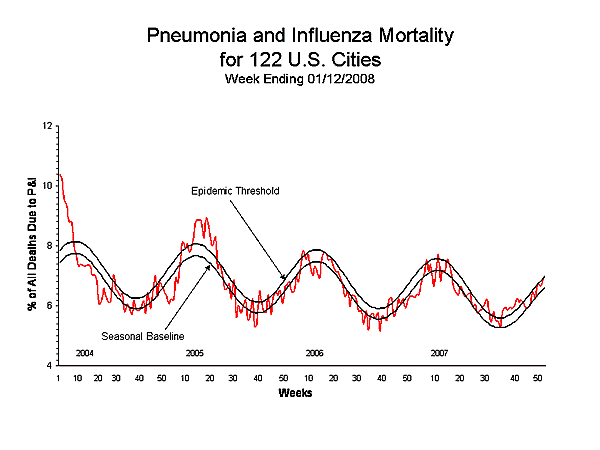
View Full Screen
Influenza-Associated Pediatric Mortality
No influenza-associated pediatric deaths were reported during week 2. One influenza-associated pediatric death occurring during the 2007-08 season has been reported.
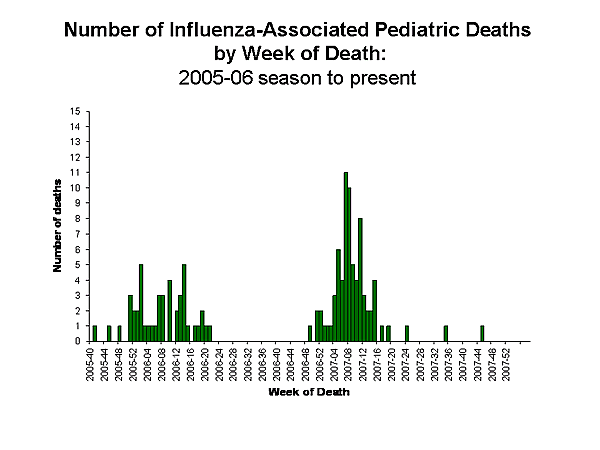
View Full Screen
Influenza-Associated Pediatric Hospitalizations
Laboratory-confirmed influenza-associated pediatric hospitalizations are monitored in two population-based surveillance networks: the New Vaccine Surveillance Network (NVSN) and the Emerging Infections Program (EIP).
During November 4, 2007-December 29, 2007, the preliminary laboratory-confirmed influenza-associated hospitalization rate reported by the NVSN for children 0-4 years old was 0.73 per 10,000.
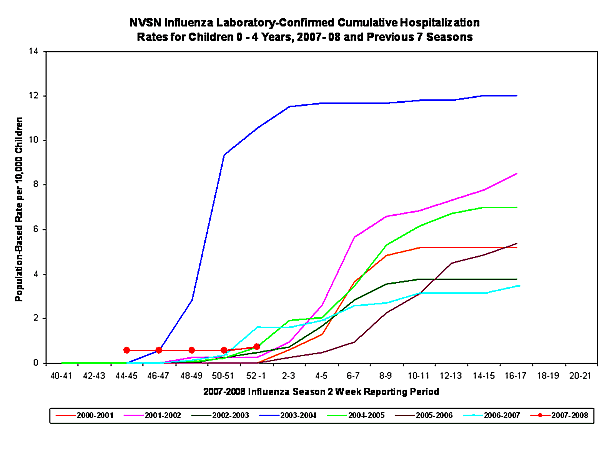
View Full Screen
During September 30 ?January 8, 2008, the preliminary laboratory-confirmed influenza-associated hospitalization rate reported by the EIP for children 0?7 years old was 0.11 per 10,000. For children aged 0-4 years and 5-17 years, the rate was 0.3 per 10,000 and 0.04 per 10,000, respectively.
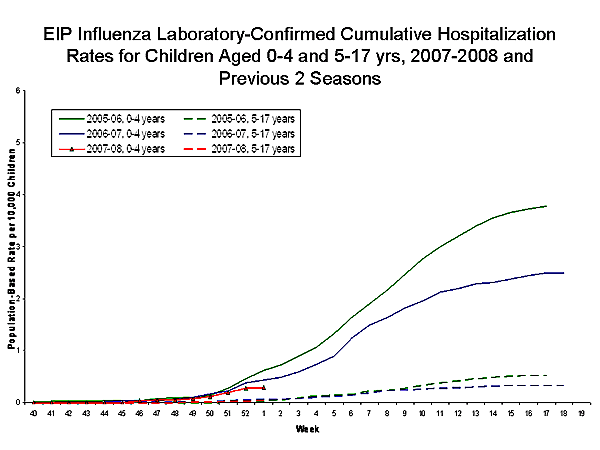
View Full Screen
Outpatient Illness Surveillance
Nationwide during week 2, 2.3% of outpatient visits reported through the U.S. Influenza Sentinel Provider Surveillance Network were due to influenza-like illness (ILI) and 2.5% of patient visits to Department of Veteran抯 Affairs (VA) and Department of Defense (DoD) outpatient treatment facilities were for acute respiratory illness (ARI). The percentage of visits for ILI was above the national baseline of 2.2%, and the percentage of visits for ARI was below the national baseline of 3.2%. On a regional level, the percentage of visits for ILI ranged from 1.3% to 5.2% and the percentage of visits for ARI ranged from 1.4% to 3.1%. The East North Central, Mountain, Pacific, West North Central, and West South Central regions reported ILI above their region-specific baselines. All nine regions reported percentages of visits for ARI below their respective region-specific baselines. All five age groups reported percentages of visits for ARI below their respective age-specific baselines.
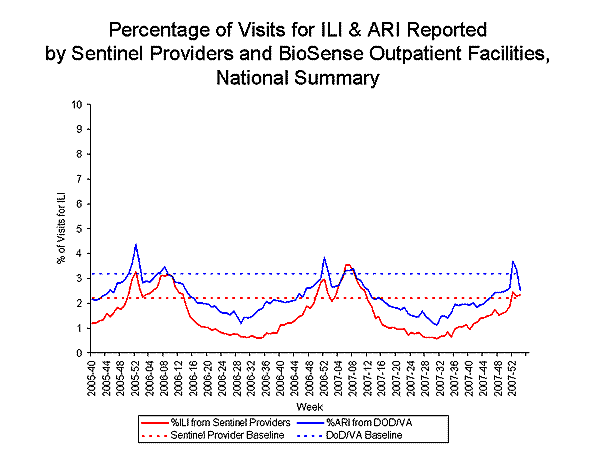
View Sentinel Providers Regional Charts | View Chart Data |View Full Screen
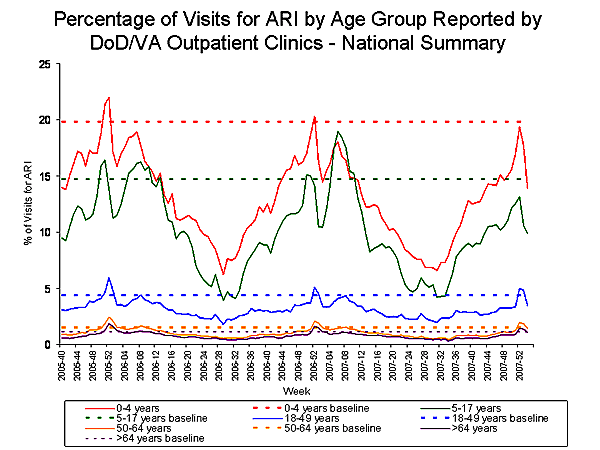
View Full Screen
Geographic Spread of Influenza as Assessed by State and Territorial Epidemiologists
During week 2 the following influenza activity was reported:
- Widespread activity was reported by four states (Colorado, Hawaii, New York, and Texas).
- Regional activity was reported by 11 states (Alaska, Arizona, Arkansas, California, Connecticut, Massachusetts, Montana, New Jersey, Pennsylvania, Rhode Island, and Virginia).
- Local activity was reported by the District of Columbia and 15 states (Georgia, Illinois, Iowa, Kansas, Maryland, Michigan, Minnesota, Nebraska, Nevada, North Carolina, North Dakota, South Carolina, South Dakota, Tennessee, and Washington).
- Sporadic activity was reported by 19 states (Alabama, Delaware, Florida, Idaho, Indiana, Kentucky, Louisiana, Maine, Mississippi, Missouri, New Hampshire, New Mexico, Ohio, Oklahoma, Oregon, Utah, West Virginia, Wisconsin, and Wyoming).
- No activity was reported by one state (Vermont).
--------------------------------------------------------------------------------
A description of surveillance methods is available at: http://www.cy118119.com/flu/weekly/fluactivity.htm
- Page last updated January 18, 2008 Error processing SSI file
